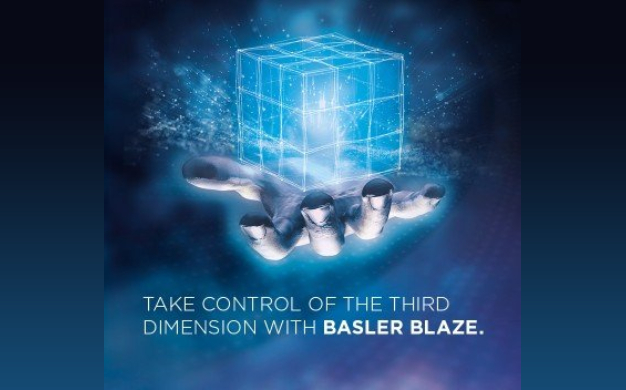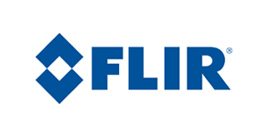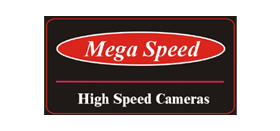Listen to this Article
Here you’ll find answers to the most common technical questions concerning time-of-flight cameras.
1. What is Time of Flight?
Time of Flight is a method for distance measurement--the time it takes for light to travel from the light source to the object then return to the sensor is measured and used to calculate a distance.
2. How accurate is the measurement of a ToF camera?
ToF cameras are accurate to a few millimeters, depending on the situation. Basler’s user manual contains a graphic with detailed accuracy measurement data.
3. What resolution does the Basler blaze camera offer?
ToF cameras have lower resolutions than modern 2D cameras due to the complexity of the ToF pixel design. The Basler blaze-101 camera offers a state-of-the-art resolution of 640 pixels (horizontal) x 480 pixels (vertical).
4. Which sensor is used in the Basler blaze-101 camera?
The Basler blaze camera uses the latest ToF-specific Sony DepthSense™ IMX556PLR sensor.
5. Does a ToF camera need to be calibrated in the field?
Every ToF camera requires calibration to achieve a reasonable accuracy. The Basler blaze-101 camera comes pre-calibrated ex-works. In-field calibration or re-calibration of the sensor is not necessary. Each blaze-101 camera has an individual calibration for lens distortion, distance error and thermal drift compensation.
However, you can configure the camera parameters further with the blaze-101 API based on the scene and object.
6. Which applications are suitable for the ToF camera?
The Basler ToF cameras are used in a variety of applications in the fields of logistics, factory automation, robotics, AGV, agriculture and medicine.
7. What is the framerate of ToF cameras?
The Basler blaze-101 camera runs at up to 30 fps.
8. How does the operating temperature affect the accuracy of a ToF camera?
Due to the high demands on the precision of light pulses and shutter speeds, ToF cameras are sensitive to temperature fluctuations. The Basler blaze-101 has several temperature sensors, which are used for individually calibrated compensation of possible signal shifts. Thus, the influence of temperature on a blaze-101 camera is negligible.
9. Can I change the lens or buy a ToF camera with another lens?
A ToF camera is a calibrated system. If focus, aperture or lens are changed, the calibration is lost. Furthermore, the illumination and lens are optimally tuned to each other in wavelength and field of view. Thus, it is not advisable to modify the lens.
10. What is the FOV of the lens?
It depends on the camera model. The field of view of the Basler blaze-101 camera is 67° x 51° (H x V). This large measuring range can cover approximately two Euro pallets or a small car at 5 m distance.
11. What kind of light source is used in ToF cameras?
ToF cameras typically use LED or laser diodes. The Basler blaze-101 camera uses four VCSEL laser diodes as its light source.
12. Are the inbuilt laser diodes eye-safe?
Eye safety is very important to us and we make high demands on the safety of our products.
Basler blaze-101 is classified as a Class 1 laser product according to EN/IEC 60825-1:2014 Edition 3. This classification means the camera is eye safe under all reasonably foreseeable conditions of normal use. The Basler blaze includes technical safety elements that ensure that the accessible emissions--e.g. via the electrical power control (electronic safety circuitry), the optical diffusor and the cover glass on the illumination--stay within safe limits. Correct functioning is guaranteed by quality management measures that include a 100% test after assembly.
13. What is the wavelength spectrum of ToF cameras?
In principle, a ToF camera can work at any wavelength as long as the illumination and sensor operate in the same spectrum. For practical reasons, the near infrared is preferred because the photoelectric effect works well in that range, but people are not disturbed because they cannot perceive the light.
The Basler blaze-101 camera works with a wavelength spectrum of 940nm. When comparing the 940nm ToF cameras with the 850nm cameras it is important to know that 940nm is completely invisible for humans, so it is a better choice in situations involving illumination of a person’s face or deployment close to humans. At 850nm, human eye sensitivity is very low but 850nm light can still be seen, especially in dark conditions. This can be uncomfortable and or confusing.
14. What is the modulation frequency of the ToF cameras?
A typical modulation frequency for a ToF camera is between 10 and 100Mhz.
In default mode (20 fps) the Basler blaze-101 camera operates at two different frequencies: 15 MHz and 100 Mhz. In fast camera mode (30 fps) the modulation frequency is 15 MHz for long range and 100 MHz for short range.
15. Can I set the modulation frequency of the camera myself? If I want to measure up to 15 m, can I set 10 MHz?
The camera performance is optimized for two modulation frequencies (15 MHz and 100 MHz) and factory-calibrated, so it is not possible to change it.
16. Can I use a ToF camera for outdoor applications as well?
Ambient light does not help with distance measurement. In fact, it fills the sensor with photons from random directions not related to the distance which thus have to be considered as a noise source.
Basler’s blaze-101 camera works under sunlight conditions. Compared to a ToF camera working at 850 nm, a ToF camera working at 940 nm is more daylight robust as at this wavelength the sunlight is strongly absorbed by the atmosphere. Also, modern artificial light sources do not emit NIR light for efficiency reasons. Please check the user manual for details.
17. Is a ToF camera working at 940nm (Basler blaze) less suitable for indoor use than a ToF camera working at 850 nm?
The quantum efficiency (QE) of a typical sensor at 850 nm is indeed higher than at 940 nm. However, the maximum permissible light exposure at 940 nm permits a 1.5X higher lighting output for cameras working at 940 nm. This compensates for the disadvantages of QE to a large extent. Furthermore, the properties of camera illumination, ambient light and other sensor properties such as dynamic range must also be considered. For indoor use of a ToF camera we recommend uniform DC lighting such as high-quality LEDs.
18. Is the Basler ToF camera supporting the GigE Vision interface standard?
Basler blaze-101 is compatible with GigE Vision standard. However, if you want to access all four streaming formats (point cloud, range map, intensity image, confidence map) and have usage of the full range of functions available, we highly recommend the Basler GenTL producer, provided with the Basler blaze SDK.
19. What is the protection class rating for the ToF camera?
If you put a ToF camera into an external enclosure, you have to make sure that the cover protection glass does not interfere with the ToF measurement.
The Basler blaze-101 camera is already rated to protection class IP67; thus, it is completely dustproof and can withstand submersion in water down to 1m for 30 minutes.
20. Can a ToF camera survive vibration and shocks?
Due to their design principle, ToF cameras are fundamentally more robust than structured light or stereo cameras, which must maintain a precise basic length.
The Basler blaze-101 camera is shock- and vibration-proof according to EN60068. The cameras were submitted to an independent mechanical testing laboratory and subjected to specific stress tests. After mechanical testing, the cameras exhibited no detectable physical damage and produced normal images during standard operational testing. Please check the user manual for test details.
21. I'd like to use the camera in an outdoor setting and want to put it into a housing. What factors require special consideration? Can I simply put the ToF camera into a standard protection housing?
Cooling is a primary consideration before mounting into a protective housing, as well as avoidance of stray light (no reflecting housing parts near the lens).
The protective glass must be translucent in the required wavelength, must be of high quality with no scratches and must not cause reflections. Ideally, the lens and the LEDs will have separate protective glasses.
22. I'd like to use multiple ToF cameras in my application.
Operating multiple ToF cameras extends your field of view and allows you to capture objects from every angle. However, the light pulse of one ToF camera can disturb the sensor of a second camera, leading to false distance measurements.
In case of Basler’s blaze-101 camera, you have several options to minimize camera interference for reliable multi-camera operation:
- 1. Use the software trigger over Ethernet. You can synchronize the cameras such that two cameras never illuminate the scene at the same time. Trigger one camera after another.
- 2. Use the Precision Time Protocol (PTP) to synchronize the timing. Instead of issuing the trigger via software (1.), you can configure the cameras to trigger themselves based on a common clock. This clock is synchronized over the network automatically (PTP protocol) down to a microsecond precision which allows very tight timing in the trigger sequence.
- 3. Use the multi-camera feature of Basler blaze. For each camera, select a slightly different modulation frequency, which yields almost no interference.
You can also combine the methods. For example, you can configure PTP so that all cameras trigger at exactly the same time, but also use multi-camera feature to minimize the interference. This is the recommended method to capture objects in motion.
23. Can I use a 2D and a 3D Basler camera within one system?
Yes, you can install the blaze SDK and the pylon SDK on one computer. The blaze SDK comes with samples; one shows the use of a blaze-101 and an ace camera in combination.
24. I have to download a GenTL Producer compliant with the GenICam standard to operate the Basler blaze camera. What exactly is that standard and why does Basler use this process?
GenTL is the third module of GenICam. While GenApi and SFNC are more oriented toward the camera's settings, GenTL regulates the transport of the image data. GenTL is the latest module.
25. Where does all this intense processing happen? On the camera or the host? What kind of CPU/GPU combination would you need?
It depends on the specific camera model you use. For example, stereo cameras often load the host processor with the depth calculation. The Basler blaze-101 camera has a very powerful NXP processor that does all the work, so the host requirements are relatively low.
26. Does the Basler blaze support ROS?
Yes, the blaze SDK comes with a driver and sample for ROS under Linux.
27. Does using polarizing filters help when working with strong reflective surfaces?
For this setup you would need an especially strong, polarized light source. This is unusual for ToF cameras.
28. How does your camera manage scattered light?
Scattered light occurs due to unwanted reflections within the lens or behind it. Even for the most carefully engineered setup, scattered light cannot be completely eliminated. Bright surfaces located very close to the light source quickly scatter too much light into the lens. This can cause measurement errors (measured distance too short). In the intensity image, scattered light leads to a washed-out image with poor contrast. The Basler blaze-101 camera has an inbuilt lens that is optimized for Time-of-Flight cameras and reduces stray light effects as much as possible. You should also remove specular objects from the scene, if possible.
29. Is it possible to install the camera behind a protective glass?
It is possible, but you have to choose a protective glass as transparent to 940nm light as possible. The protective glass must not cause reflections. Please also consider that the latest model blaze-101 is rated to protection class IP67, so it is splash water and dust resistant.
30. Do you have any plan to sell high resolution versions of this TOF sensor?
Currently VGA resolution is state-of-the-art for ToF cameras. But across the product life cycle, we closely observe innovations in the ToF sensor market, and newer sensor models will be taken into consideration for future camera models as they are released.
Also Read: INTRODUCTION TO VISION SYSTEM COMPONENTS
Back to All Robotics and Autonomous Systems Articles, Resources and News
Share This:
For more information on Cognex Machine Vision Systems India Contact us at MVAsia Infomatrix Pte Ltd +65 6329-6431 or Email us at info@mvasiaonline.com
Source - cognex.com































